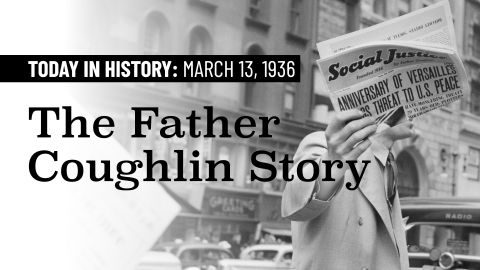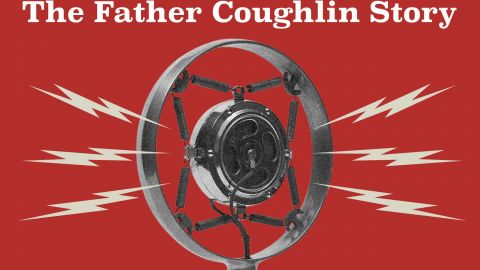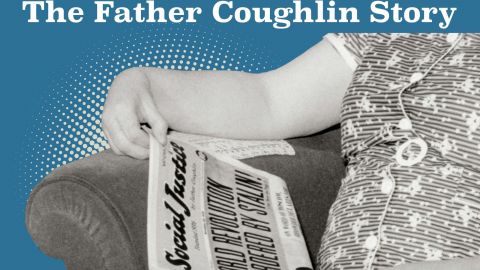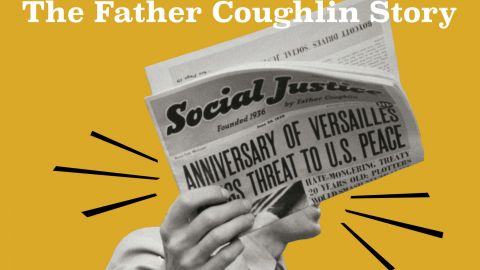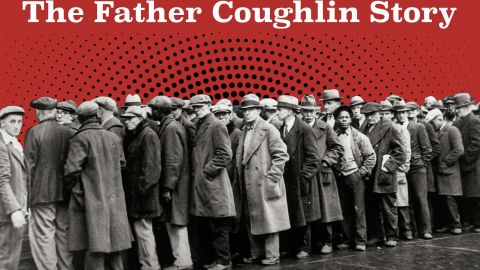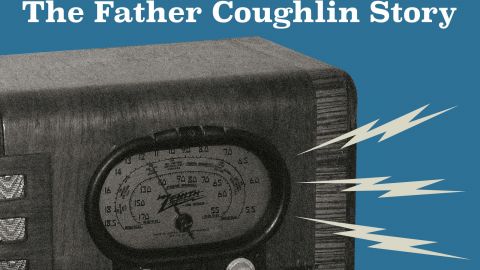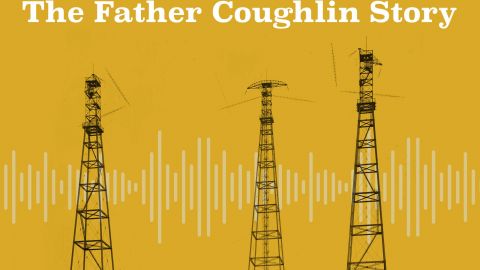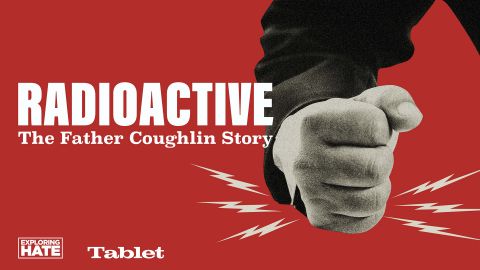The following is a production of Tablet Studios in association with The WNET Group’s reporting initiative, Exploring Hate: Antisemitism, Racism and Extremism, and with support from Maimonides Fund.
Andrew Lapin: You know how some neighborhoods have a house all the kids believe is haunted? A really creepy place you’d rather cross the street than walk right by? Growing up in Detroit, we had the Shrine of the Little Flower. It’s right on the corner of Woodward Avenue and 12 Mile Road in Royal Oak, Michigan. Royal Oak is not the kind of place you’d associate with horror or danger. It’s where you’d go to enjoy the Detroit Zoo, which was just around the corner from my childhood home, or to grab a Coney Island, a local delicacy—that’s a hot dog with chili and diced onions on top, served on a steamed bun. It’s the sort of home you think about when you daydream about making it in America. And the church itself, the Shrine, fits right in with this picture. It’s a beautiful art deco building planted right in the middle of a gorgeous lawn. So why were we so afraid of it? Why, growing up, did I get chills running down my spine every time I passed the shrine of the Little Flower? Maybe it was the Charity Tower, one hundred foot tall, slim but muscular edifice with an enormous Jesus carved on the side, looking down at all of Detroit, but especially, it felt, at us Jewish kids. Or maybe it was the spirit that still haunts it, the spirit of the man who built the tower, whose likeness is still enshrined inside of it. The person who was America’s first big radio star.
Charles Coughlin: And that day is now because others inside the church and outside the church are trying to get rid of Jesus Christ. The super man,
Andrew Lapin: A man who mixed religion and politics to a shockingly effective degree:
Charles Coughlin: Whither goest thou to Rome again to be crucified. To Rome where dwell the Caesars of wealth, of lust and power.
Andrew Lapin: A man who cheered on Hitler, wrote fan mail to Mussolini and celebrated fascist leaders the world over.
Charles Coughlin: We will fight you in Franco’s way if necessary. Oh, it’s inflammatory. It is inflammatory.
Andrew Lapin: A man who had so many fans that when he spoke at Madison Square Garden, they had to open up the basement to let them all in.
Charles Coughlin: I dared you and challenged you to organize so that the people, if not their president, would drive the money changers from the temple. And you did it.
Andrew Lapin: A man who helped bring down one president and elect another and was himself obsessed with getting closer and closer to the White House. A man who was under investigation for treason. A man who realized that populism and celebrity and bigotry could get you very far in America.
Charles Coughlin: The same controls are being used to deceive the common people. The same propaganda is issued by those who dominate both governments and nations. The hidden hand of the internationalist.
Andrew Lapin: A man who was one of the most notorious antisemites in American history.
Charles Coughlin: We are Christian insofar as we believe in Christ’s principle of love your neighbor as yourself and with that principle, I challenge every Jew in this nation to tell me that he does not believe in it.
Andrew Lapin: A man whose legacy is as urgently relevant today as it was when he first took to the radio to make Americans love him and hate one another.
Charles Coughlin: Oh God, deliver us from false prophets, false leaders, and false philosophy. Oh God, deliver us. God bless.
Andrew Lapin: I’m Andrew Lapin and this is Radioactive, an eight part series from Tablet Studios and Exploring Hate about Father Charles Coughlin, the famous radio priest, notorious antisemite, and a man who changed American culture and politics forever. Father Coughlin’s story isn’t just the tale of one man’s unlikely ascent to power, it’s also the story of how America came to be the country. It is today a story of a new medium of mass communication, barely regulated yet immensely influential. A story of a new industry creating an explosive center of creativity, wealth and influence. A story of economic turbulence and radical populism. A story of a private militia armed to the teeth and ready to march on the nation’s capital. And a story of the Jews who were caught in this turbulence, blamed, as always, for everything. All these tales unfurl from the story of one demagogue, the skills that made him successful and the forces that eventually brought him down.
Music: Here comes Father Coughlin wearing a silver chain, cast on his stomach, and Hitler on the brain.
Andrew Lapin: Episode One: In the Beginning.
Music: I’m going to tell you workers before you cash in your checks. They say America first, but they mean America next.
Andrew Lapin: When you step inside the church that Father Coughlin founded, you can barely tell that this priest once held the world in his hands. At the Shrine of the Little Flower, which Detroiters just know as Shrine, Coughlin’s portrait still hangs on the wall, and some of his belongings are framed behind a glass case in the lobby. The church celebrates him as the first leader of their great flock and tends not to talk about the other stuff.
Monsignor Robert McClory: In my day to day pastoring, his name comes up very, very rarely.
Andrew Lapin: Monsignor Robert McClory was until recently, the pastor of Shrine. When I first visited him at the church in 2018, he told me he didn’t think about its founder all that much.
Monsignor Robert McClory: I really hear very little people talking about any of his political engagement. Most of the people here, to the extent that they remember him at all, would be certainly the older generation. And their comments would be that if you had the school mass, you know you weren’t going to have any classes that morning because he would preach for so long. I mean, those kind of anecdotes. I think we have a beautiful church that he built. We try and serve the people of God through it. But again, I really have to say, Andrew, on a day-to-day basis, I don’t encounter a lot of conversations about him.
Andrew Lapin: After a series of anti-Semitic events unfolded across the country in 2018, McClory and Shrine decided to have more conversations about Father Coughlin. We’ll get to that in a later episode. But how does the rest of the world remember Father Coughlin and why, for generations, have Jewish Detroiters called his church the Shrine of the Little Fascist?
Thomas Doherty: Father Coughlin was the most infamous radio priest to this day in the 1930s. He had an audience of anywhere from 15 to 20 million listeners throughout most of the 1930s.
Andrew Lapin: Thomas Doherty is a historian at Brandeis University. His area of research is American culture, a culture that, in the 1930s, was rapidly changing. Or more accurately, being rapidly changed by a new mass medium: radio.
Thomas Doherty: It’s the first broadcasting medium of American history. In a way, it’s going to set the pattern for everything else that came afterward, because whether it’s television or the internet today, radio broadcasting was the first universal simultaneous medium in which you could command an audience of millions of people at the same time. So the sheer specialness of what radio was in the 1930s and it reaches it what media scholars call a level of penetration around thirty one and thirty two, and that’s just a fancy way of saying most people who wanted to listen to radio could listen. They had one in their living room, you know, a neighbor down the hall might of or in a lot of famous stories, you could sort of walk down the street when a popular radio show was on, like Amos and Andy in the late 20s, early nineteen thirties and not miss a second of the episode because the broadcast would be coming out from the windows of every apartment down the street and that sort of sensoral arm of noise that we associate with modern life first starts in the 1930s, and Coughlin is one of the people who’s there at the ground floor.
Andrew Lapin: Increasingly, as you were walking down the streets of America, the sound that came at you from every corner was the voice of Father Charles Coughlin.
Charles Coughlin: Form your ranks in the church militant. This America is Christ’s America.
Andrew Lapin: Why was he so popular? After all, he was a Catholic priest in an overwhelmingly Protestant country. Not really anyone’s idea of a celebrity. Father Coughlin, like all good politicians and entertainers, had one thing going for him. He had an impeccable sense of timing. His rise coincided with one of the lowest points in American history, the Great Depression.
Archival newsreel: The richest country in the world began a bitter journey downhill.
Andrew Lapin: Coughlan understood that economic uncertainty gave way to political turmoil, which made people scared and when people were scared, they desperately sought a calm and reassuring voice. That, says Doherty, is why times of turmoil breed dangerous demagogues.
Thomas Doherty: He’s speaking to the sense of chaos that people feel towards the economic deprivations people feel. And then ultimately, of course, the demagogue is going to give a solution to your problems. And typically these solutions are at least in the American tradition, nativists. They’re kind of ugly. They’re kind of over simple, and they tend to demonize one group to blame for the pain that you are feeling.
Andrew Lapin: How did Father Coughlin become the man millions turned to in their time of need? And why did he focus so much of his anger on Jews? To answer these questions, you need to go all the way back to the last decade of the 19th century, when Charles Coughlin was born in a frozen corner of Canada. Charles Coughlin’s story begins far away from the bustle and boom of America. It begins outside of Toronto in a town called Hamilton, Ontario, where he was born in 1891. His father, Tom, was the sexton of the local church, which meant he kept watch over the grounds. In fact, the Coughlin’s practically lived in their church’s backyard, and little Charles could hear the organ playing from his bedroom. He had a younger sister too, Agnes, but she passed away as a baby, leaving Charles an only child. This left his mother, Amelia, grief stricken. Often she’d dress her boy in girls clothing, which usually meant that Charles couldn’t run around and play with his friends. Not that Amelia minded. A devout Irish Catholic, she didn’t want her son playing sports or roughhousing with his pals. She wanted him preparing for the only career she imagined worthwhile: the priesthood.
Charles Coughlin: Well, this is the day which the Lord has made, the day which pledges to all of us who love Christ, who follow Christ and who live for Christ’s principles that the bonds of friendship are immortal and the joys of heaven are real and eternal.
Andrew Lapin: Serving God required hard work and dedication. Charles showed little of either. At the University of Toronto, where he enrolled in 1907, he got one A, seven B’s and 17 C’s. It’s not because he wasn’t smart. It’s because he only applied himself to the things he loved doing. The thing he loved doing more than anything was performing, especially Shakespeare. His favorite kind of show to perform, however, was the kind that made everyone else stop and listen to him. One afternoon in theology class, one of his professors assigned the students to speak for 20 minutes without notes. Coughlin spoke for nearly an hour and a half. Recounting this to biographer Don Warren years later for his book radio priest, one of Coughlin’s friends recalled what it was like to see the young preacher thundering.
Actor: There were a great many quotations in his talk, but they were mostly from the apocrypha, which Coughlin knew the others weren’t very familiar with. And although he ended with a text that contradicted the whole point of what he’d been saying, they were so caught up in the torrent of his rhetoric that only a couple of them realized it.
Andrew Lapin: The quotes, of course, were fake, Coughlin had made them up, but it didn’t matter. He had gained a reputation as someone worth listening to: a star. His reputation helped him get into Saint Basil’s Seminary in Toronto and quickly completed his studies. He began to construct his own legacy. When Coughlin was still a seminary student, Amelia fell ill. Her son took a brief leave of absence. When he returned, he reported to his friends and superiors that his mother had been at death’s door. He explained that he knelt in prayer at her bedside and was able to perform a miraculous recovery. In 1916, Charles Coughlin was ordained. He finally became Father Coughlin. He was 25 and ambitious. So when he was offered a job on the faculty of an all-boys Catholic college in Sandwich, Ontario, he said yes. Today, Sandwich is called Windsor. If you visit, it’s easy to see why it might have appealed to him back then. Step to the banks of the river and you’re a stone’s throw away from Detroit.
Joel Stone: Was Detroit a model American city in the 1920s? That’s a great question.
Andrew Lapin: Joel Stone is curator of the Detroit Historical Society. Detroit, he says, was like the Silicon Valley of its day, not only a hub of innovation and economic growth, but really almost a metaphor for American ingenuity.
Joel Stone: We had a growing middle class funded by the various automobile companies that were growing. We were building more single family homes than anyplace else in the country, but also more apartment buildings and beautiful, beautiful skyscrapers. There was a wonderful standard of living here. The flip side of that was people who worked in factories worked very, very hard. They usually worked six days a week, 10 to 12 hours a day. It was dangerous work, and while they were making money, it still was relatively low wage. Prohibition, as much fun as it brought to the city, as far as places that people hung out in the music that was produced, there was also a lot of strife caused by that. Strife within families, strife within organized crime, strife within the law enforcement. There were so many people on the take during prohibition that people stopped trusting law enforcement. It was a wide open Wild West town.
Andrew Lapin: Every Wild West Town has its share of big characters. And Detroit had the biggest of them all. Henry Ford, the man who shaped the city and so much of American culture in his own image. From across the river, Father Coughlin was following Ford with admiration. Here, he realized, was another boy born to humble beginnings and catapulted to greatness by his own gumption. It wasn’t much of a stretch. The story of Henry Ford’s life could inspire even folks with far less faith than Father Coughlin. Ford was one of five poor children growing up on a farm in Springswell Township, Michigan. He hated farming. Instead, he spent every free moment tinkering. Just before he turned 30. He took a small two-cylinder motor, hooked it on to a counter shaft by a belt and then to a rear wheel by a chain. He threw in 28 inch wire bicycle wheels, a foot brake and a three gallon gasoline tank. It was 1892, and Henry Ford had just built his first motor car. In no time, the Ford Motor Company would launch its namesake to the height of fame and influence. He was so powerful that he thought he could save the world. But great heights, alas, invite great falls.
Dr. Catherine Cangany: During World War I, he had had this naive but well-intentioned idea to get a ship, a peace ship and sail off to Europe and kind of roll into a harbor somewhere in the midst of the front and say, “Let’s stop the fighting, let’s all pull together and let’s make the world a peaceful place.”
Andrew Lapin: Dr. Catherine Cangany is the executive director of the Jewish Historical Society of Michigan. She studied Henry Ford’s relationship to Jews.
Dr. Catherine Cangany: And of course, the press had a field day with it, and he did take a ship and he did go to Europe, although not anywhere close to the scene of the fighting. And it was a disaster and he felt mocked and humiliated, and ultimately he would go on to blame the impetus for doing that on a Jewish woman. So he decided that a way to prevent the press from skewering him going forward, he was going to get his own paper and then also spew this hatred about Jewish people.
Andrew Lapin: Why the Jews? Professor Doherty?
Thomas Doherty: Why the Jews? I mean, that is always the question, isn’t it? Why the Jews and part of it is, well, we do have this eight-hundred-year history of anti-Semitism, which the anti-Semitic demagogue can play off of. And I think in the 30s especially, and this is, I think, something you always have to keep in mind when you’re talking about anti-Semitism in America, in the nineteen thirties and you have to keep two things in mind. On one hand, it is a decade of renaissant anti-Semitism and assault on American Jews in public life. But on the other hand, the 1930s is a terrific decade for American Jewish achievement. If you think of sort of some of the emblematic names to the 1930s, who’s the most admired scientist? Einstein. Who’s the most popular person on radio? Jack Benny. Popular baseball players like Hank Greenberg. American Jews in the 1930s have never achieved so much, had such success, had such a high profile, had lived the American dream so well, as in the 1930s. That very achievement produces the kind of reactionary countermeasure.
Andrew Lapin: No one was more reactionary than Henry Ford in the early 20s. Ford bought a small newspaper, the Dearborn Independent, and turned it into one of the most widely read papers in the country. Ford used its pages to spread conspiracy theories about Jews.
Dr. Catherine Cangany: The issue that really begins the anti-Semitic content happens in the spring of 1920, and the headline on the front page is “The international Jew: the world’s problem.” The other reason for that for the Dearborn Independent’s existence, was to popularize and prove the protocols of the Elders of Zion. So the protocols of the Elders of Zion are this notorious 1903 Russian forgery. They’re purportedly the secret minutes of this organization of Jewish people who was going to take over the world, and it was a conspiracy of how they were going to do it.
Andrew Lapin: Across the river in Canada, Charles Coughlin was paying close attention. He looked at Henry Ford as an example of what a man could become if he applied himself, trusted his ingenuity and by virtue of wealth, talent, or both had access to mass media. He couldn’t wait to get to Detroit, meet the car magnate, and join in on the good life. For the time being, Coughlin was stuck on the wrong side of the Detroit River, with his students and his small-time job. As he’d always done, he focused mainly on what he cared about: staging elaborate plays, rather than spend too much time teaching theology. He also convinced his students to build him a new house, and such was the charisma of the young, bespectacled teacher with the tall forehead and the glimmering eyes that the teens toiled for free, building Coughlin a home from scratch, never once being paid. When the house was ready. Coughlin hardly ever stayed in it. The only home he ever wanted was in America. Father Coughlin might have never experienced any of that jazz. He might have lived out his life as a small-town Canadian priest, unknown by any but his handful of parishioners. Then his order, the Basilians came knocking. It was time, they said, to get serious. The Basilian order had three central tenets. When Coughlin joined them, members were asked to take vows of obedience, chastity and stability. That’s doable enough for any Catholic priest. While Coughlin was preparing for the seminary, the Basilians added a fourth vow: poverty. Under the Basilians, Coughlin saw one version of a future laid out before him. It would be a life of humility, privacy, self-sacrifice– devoted to the well-being of others. That didn’t gel with this priest. Whatever else Charles Coughlin was about, Charles Coughlin was his top priority. So in the spring of 1924, he severed his ties with the Basilians, quit his job and moved across the river. His students weren’t surprised in the least. “You have to allow for the wind,” one of them told Warren years later. “Genius is always that way. They create a wind. Coughlin was that way.” Everyone in Sandwich, Ontario knew Coughlin was ambitious, but no one could imagine that this impatient priest would in just two years establish a massively successful church of his own, revolutionize mass media and find his way to the front row of a new class of Americans celebrities.
Radio announcer: Good afternoon, ladies and gentlemen. Today, Father Coughlin brings to you the most important address. It is a challenge to American labor. It is a challenge to American citizens who are wearied with the propaganda of communism and Nazism. Ladies and gentlemen, and friends, it is evident from my mailbag that the laboring men of America are being propagandized. As a result, labor is confused. Irresponsible writers and speakers are constantly informing labor. But Father Coughlin and social justice are not the age.
Andrew Lapin: Next week, how Babe Ruth and the Ku Klux Klan helped Father Coughlin become the radio priest. Radioactive is hosted by me, Andrew Lapin, and is a production of Tablet Studios in association with The WNET Group’s reporting initiative Exploring Hate: Antisemitism, Racism, and Extremism, and with support from Maimonides Fund. The show was produced and edited by Josh Kross and Robert Scaramuccia with Quinn Waller. Our managing producer is Sara Fredman Aeder. Our executive producers are Liel Leibovitz and Stephanie Butnick. Our theme music is from the ghostwriter and was composed by Alexandre Desplat. All speeches and material of Father Coughlin are authentic to the source, as well as music and other audio from his radio program. Voice acting in this episode by Daniel Strauss. The series was recorded at Michigan Radio, Ann Arbor’s NPR Station and WDET, Detroit’s NPR station. Recording engineers at Michigan Radio are Peg Watson and Bob Scott, recording engineer at WDET as David Leins. Special thanks this episode to Bill Healy, Zoe Clark, Mike Skinner, the PRX Google Podcast Accelerator Program and the late Don Warren, author of the Father Coughlin biography “Radio Priest.” Please go rate and review us wherever you listen to podcasts. For more information about the show, please visit tabletmag.com/radioactive.
Major funding for Exploring Hate has been provided by: The Sylvia A. and Simon B. Poyta Programming Endowment to Fight Antisemitism, Sue and Edgar Wachenheim III, Charlotte and David Ackert, The Peter G. Peterson and Joan Ganz Cooney Fund, and Patti Askwith Kenner. For a complete list of funders, please visit pbs.org/exploring hate.

